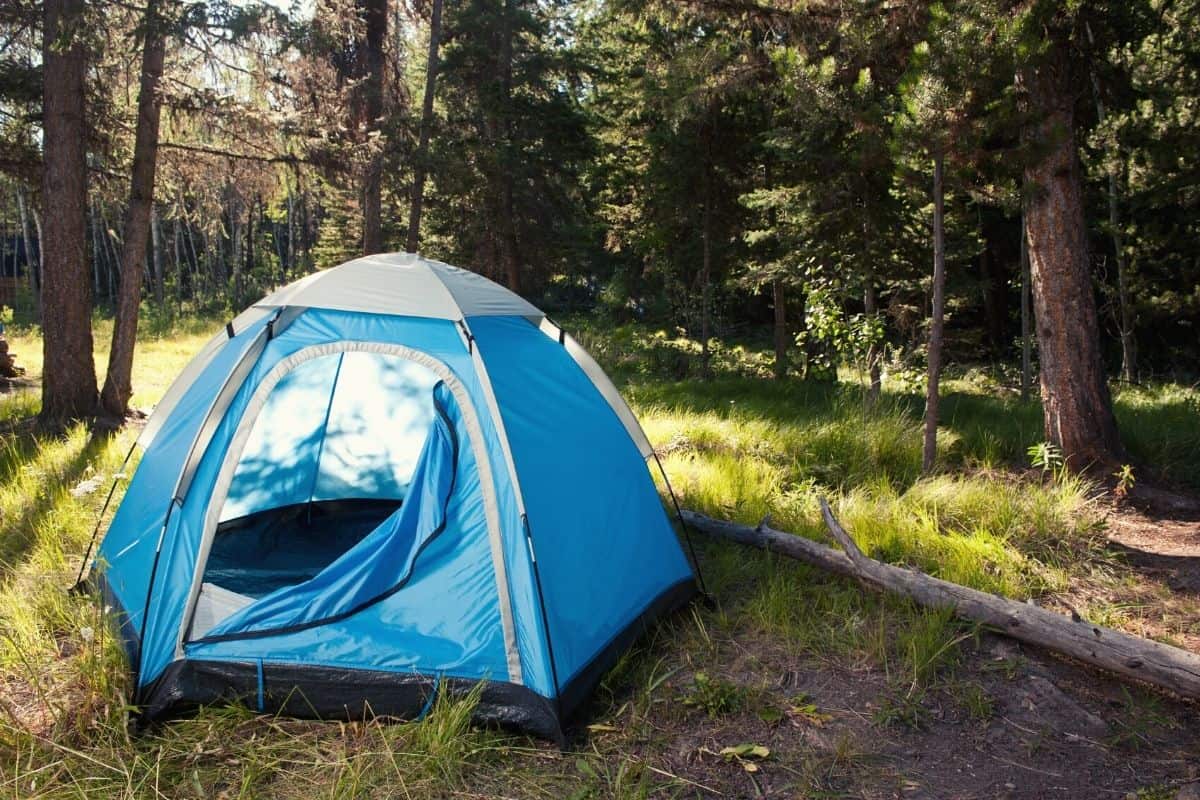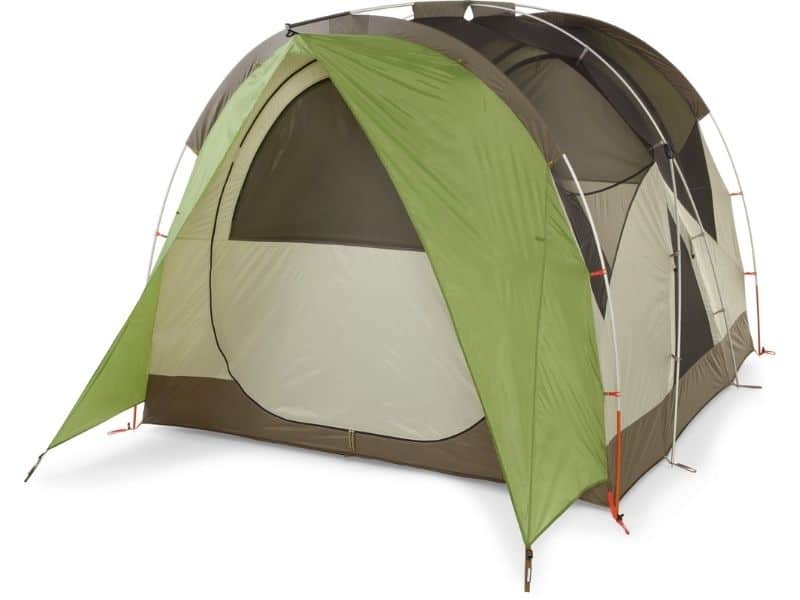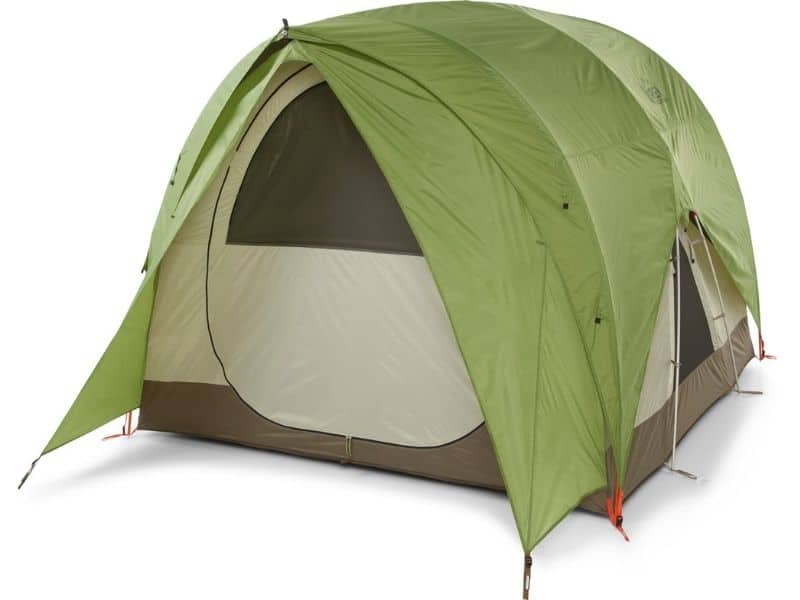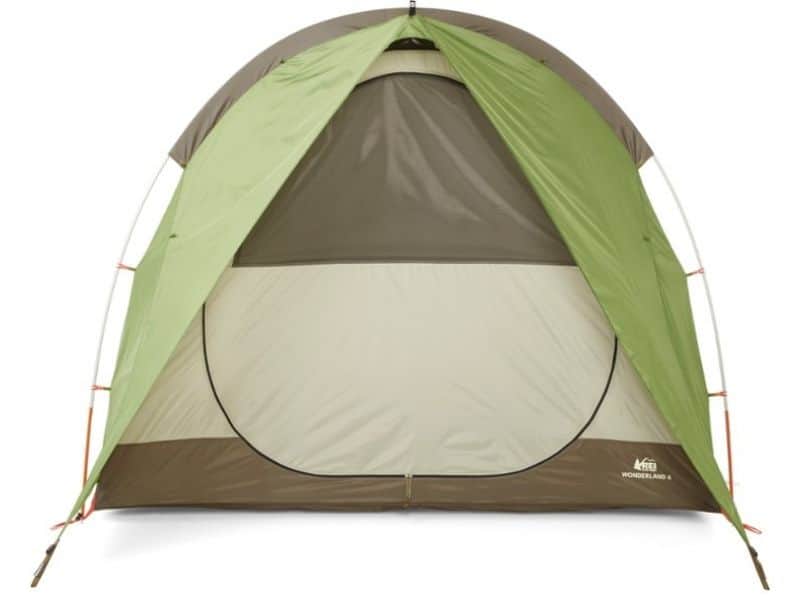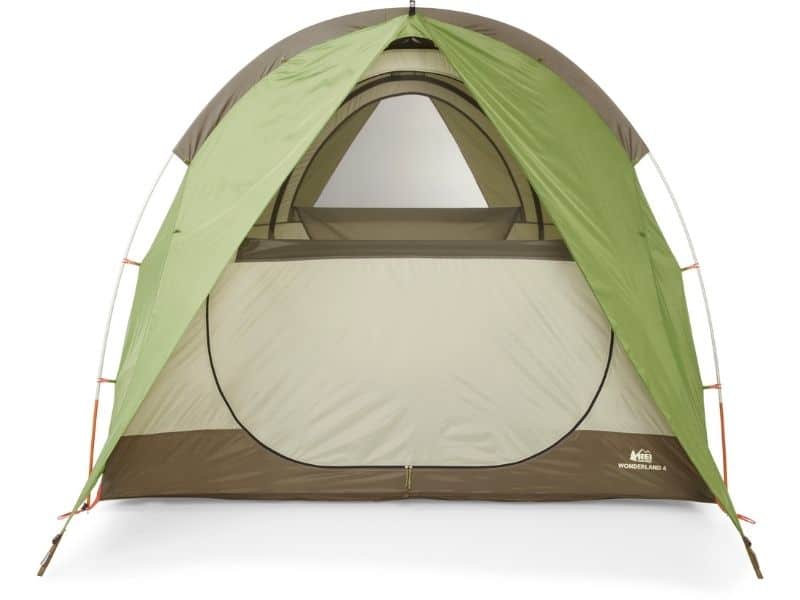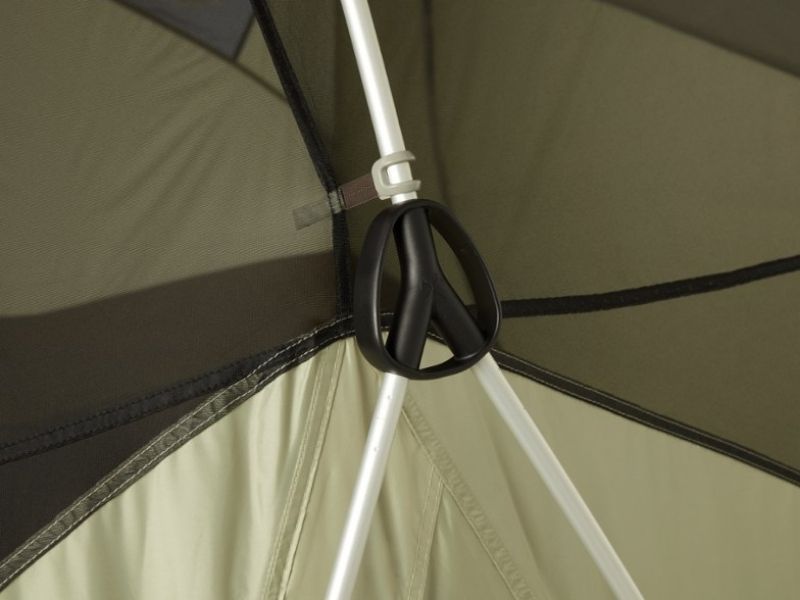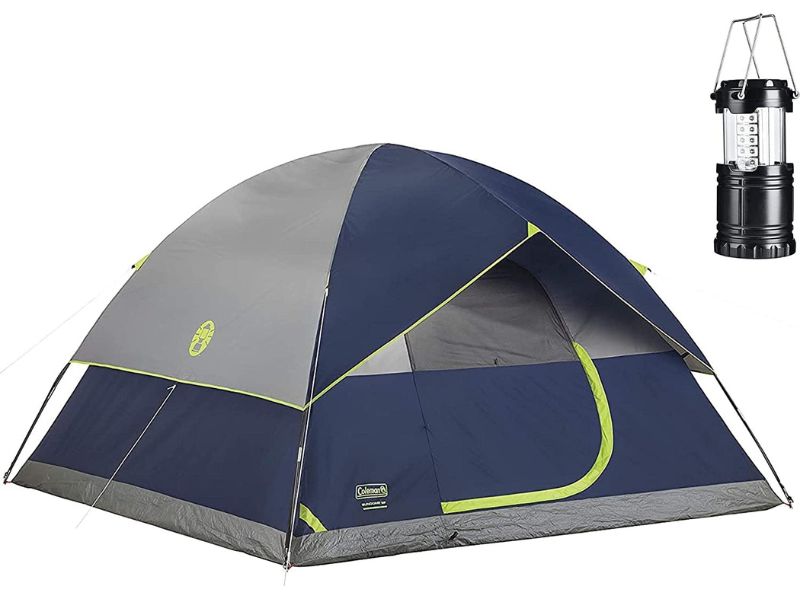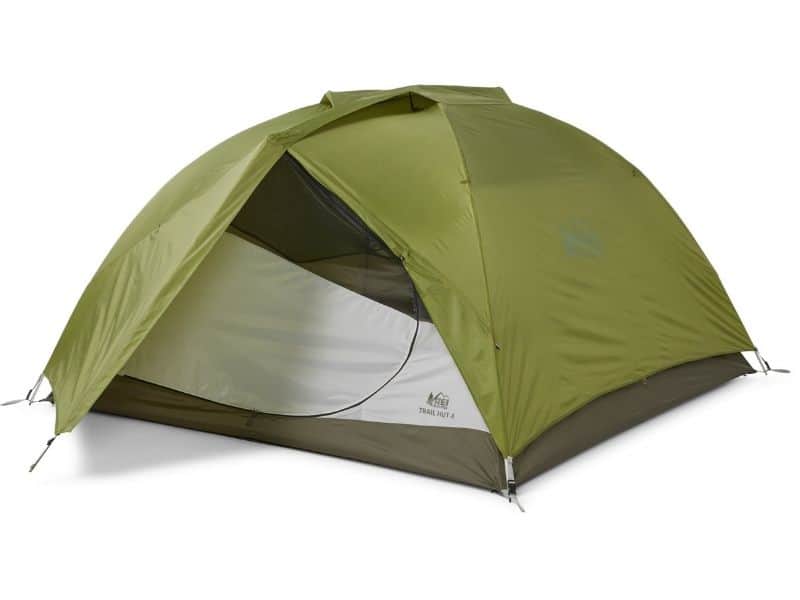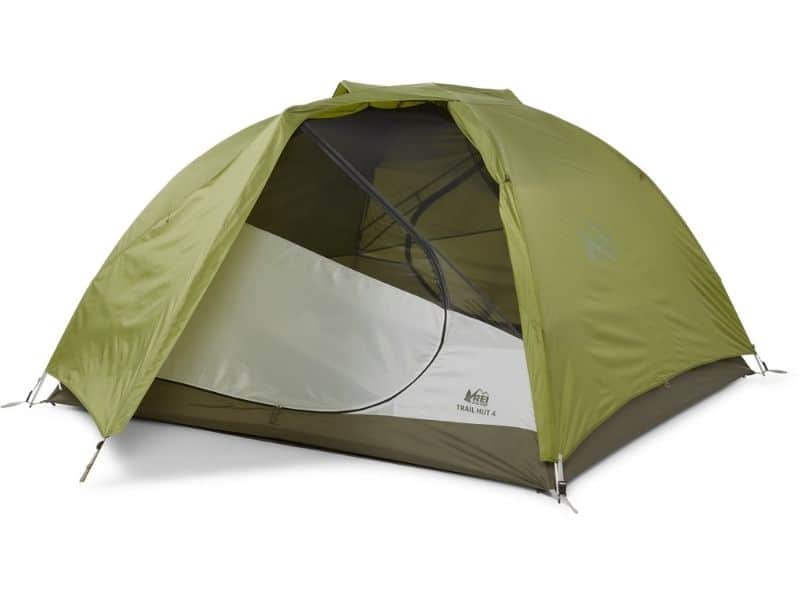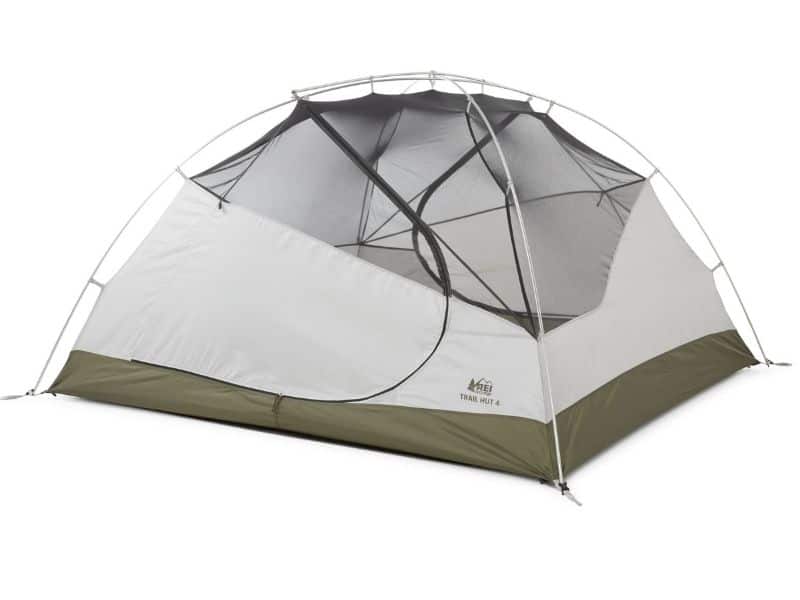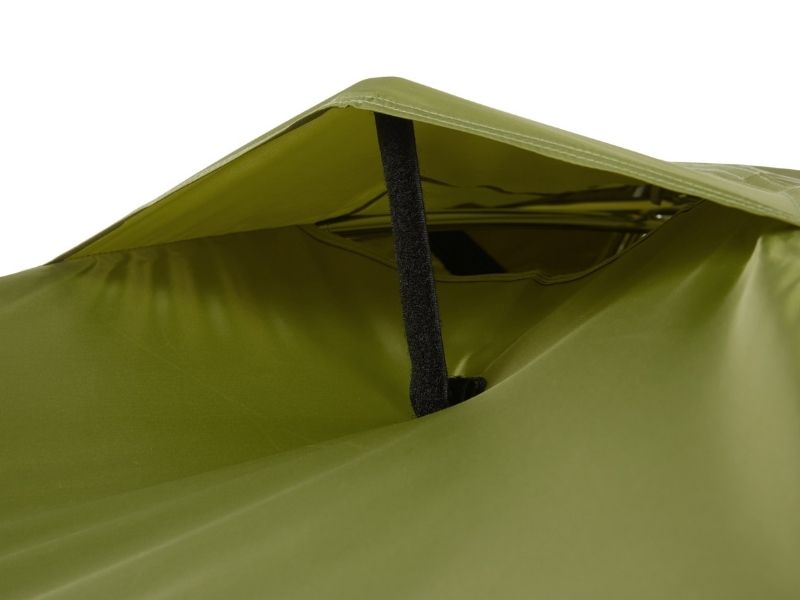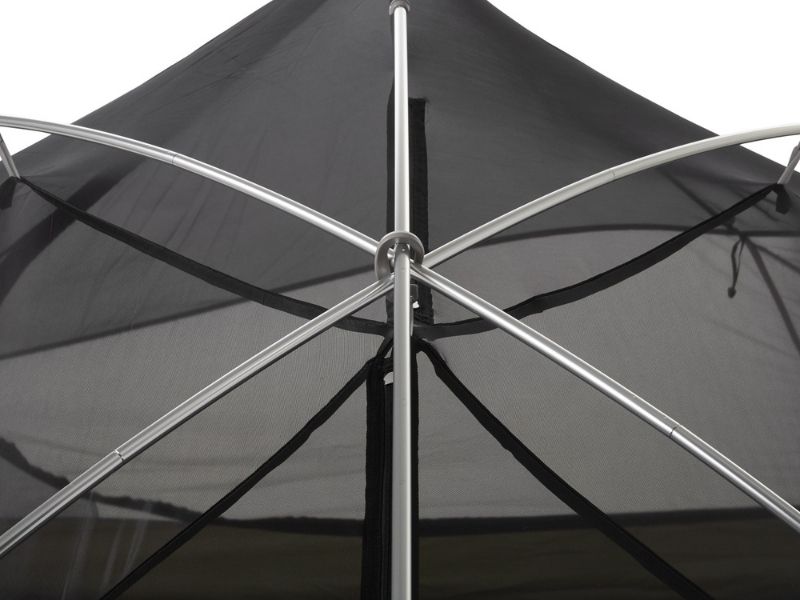We believe the R.E.I. Wonderland stands out as the best overall 4-person tent. It offers ample room and abundant storage for equipment, ensuring reliable performance in severe weather conditions.
If the Wonderland doesn’t meet your needs we have also tested numerous other tents over the year and have shortlisted the following alternatives, REI Co-op Wonderland, Coleman Sundome, Thule Tepui Explorer Autana, REI Trail Hut, Nemo Wagontop, Kelty Wireless, and Eureka Copper Canyon LX.
We will also explain what features are important to consider when making your purchase, including floor space & peak height, weather protection, ventilation, durability, Ease of Use, weight & packed size, and storage space.
Table of Contents
At a Glance: Quick Recommendations
-
Editor’s Choice:
REI Wonderland 4
“With a spacious interior, lots of gear storage, and great ventilation and waterproofing, it’s easy to see why this family-sized tent is the top choice for car-camping families.” -
Best Budget :
Coleman Sundome 4
“If you want a simple, cheap four-person tent for the occasional summer camping trip, then the Coleman Sundome is a great option.” -
Best Rooftop:
Thule Tepui Explorer Autana 4
“If you want a mobile tent for the roof of your vehicle, then it is hard to beat the easy setup of the rugged Thule Tepui Explorer Autana.” -
Best Four-Person Tent for Backpacking:
REI Trail Hut 4
“If you intend to do a little backcountry camping then the lightweight Trail Hut 4 is ideal, boasting enough room for car camping and a light enough weight for backpacking.” -
Runner-up:
NEMO Wagontop 4
“The NEMO Wagontop is the most liveable tent in our line-up thanks to its steep cabin walls, huge interior, and lofty peak height of 6’ 6”.” -
Best Value:
Kelty Wireless 4
“The Kelty Wireless might not offer the same quality as pricier picks, but it ticks all of the important boxes.” -
Best Tent for Tall People:
Eureka Copper Canyon LX 4
“Ideal for the taller camper looking for a shelter they can stand up in at an affordable price.”
Top Picks by Category:
Budget: Coleman Sundome 4 and Kelty Wireless 4
Backpacking: Coleman Sundome 4 and REI Co-Op Trail Hut 4
Features: REI Wonderland 4
Space: REI Wonderland 4, NEMO Wagontop 4 and Eureka Copper Canyon LX 4
Which are the best 4-person tents?
From four-person camping tents to backpacking tents and beyond, we’ve trialed and tested dozens and narrowed down our favorite 7 tents in the list below.
- REI Co-op Wonderland 4
- Coleman Sundome 4
- Thule Tepui Explorer Autana 4
- REI Trail Hut 4
- Nemo Wagontop 4P
- Kelty Wireless 4
- Eureka Copper Canyon LX 4
REI Co-op Wonderland 4
Editor’s ChoiceType: Tunnel ⸱ Floor: 69.4 sq. ft. ⸱ Height: 6’ 3” ⸱ Rainfly: 1500 mm ⸱ Weight: 21 lbs. 11 oz.
The REI Wonderland 4 earns our highest accolade this year, excelling in all categories, especially in terms of its roomy interior, effective ventilation, and numerous storage possibilities. It encompasses all the desirable features for an outstanding 4-person tent, making it perfect for family outings.
The REI Wonderland ties for the most spacious interior of any four-person tent in our review at 69.4 sq. ft., making it large enough to fit two double air mattresses with room to spare. The tunnel design, which features a “scalloped” design to help pull the ventilated mesh roof outwards, creates near-vertical walls and makes the 6’ 3” peak height almost uniform from end to end.
The 1500mm 75D rainfly and 150D bathtub floor are among the most durable we came across in our review (only the Wagontop had a more durable floor at 300D) and have sufficient waterproofing to see you through all but the worst of storms.
The dark mesh body and roof vents allow great air circulation, and if the weather allows, the rain fly can easily be rolled back for a spot of stargazing.
The one major drawback to the Wonderland is the lack of an enclosed vestibule. However, there are plenty of interior pockets, a large front awning, and enough interior space for gear storage. This problem can also be rectified by adding the REI Mud Room (sold separately), which adds a further 56 sq. ft. for extra gear storage or a little more living space. If you need more space, then the Wonderland is also available as a six person tent.
The Wonderland is an expensive tent. If you want a cheaper option, we would recommend the Eureka Copper Canyon, which is a step down in quality but has all the essentials at a lower price.
PROs
- Roomy interior
- Large awning
- Color-coded poles
- Great peak height
- Great ventilation
CONs
- Higher price point
- Heavy and large packed size
- No vestibule
Bottom-Line: Spacious, easy to pitch, waterproof, well-ventilated, and, all in all, a great family tent for car camping adventures.
Coleman Sundome 4
Best BudgetType: Dome ⸱ Floor: 63 sq. ft. ⸱ Height: 4’ 11” ⸱ Rainfly: 600 mm ⸱ Weight: 9 lbs. 13 oz. ⸱
The Coleman Sundome is a great option if you’re looking for a cheap 4-person tent for the occasional camping trip in fair weather. It is the best 4-person car-camping tent at this price point.
Weighing in at just under 10 pounds (9.13 lbs.), the Sundome is one of the lightest tents we reviewed and could be used for backpacking if you were to distribute the weight amongst your camping companions. Only the REI Trail Hut 4 is lighter (8.16 lbs.).
The Sundome offers a generous 63 square feet of floor space, but the dome-style design, and a low peak height of 4’ 11” do mean that head and shoulder space is limited. If you want more headroom you’ll need to pay a little more for a cabin tent like the Eureka Copper Canyon, which offers 64 square feet of floor space and 7 feet of headspace.
While Coleman claims that the Sundome is a 4-person 3-season tent, we are a little pessimistic about its chances of being used in the early spring or late autumn. It has a partial-coverage rainfly with a lowly 600 mm rating, making it suitable only for light, short-lived showers.
All in all, then, the Coleman Sundome tent is a great option for its price and a good shout for fair-weather camping, but it is limited in terms of performance compared to other tents in our review.
PROs
- Affordable
- Lightweight
- Roomy
- Easy to pitch
CONs
- Not very waterproof
- Lack of storage (no vestibule)
- Single entry point
Bottom-Line: Short on waterproofing and storage, but a great option for summer camping.
Thule Tepui Explorer Autana 4
Best Rooftop ModelType: Rooftop ⸱ Floor: 48 sq. ft. ⸱ Height: 4’ 8” ⸱ Weight: 180 lbs.
For car camping, mounting a tent on your van or truck’s roof is a viable option, and we recommend the Thule Tepui Explorer Autana as the top 4-person rooftop tent. This solid tent is easy to set up and is as mobile as your truck is.
Made from a 600D ripstop cotton/polyester blend and welded aluminum poles, this is more durable than the other 4-person tents we reviewed.
It comes with a high-density foam mattress, removing the need for bringing separate sleeping pads. However, this does mean it weighs a whopping 180 lbs. and will take a couple of folks to get it attached to your truck. Once attached to the roof, however, it can single-handedly be taken down again in just a few minutes.
At only 48 square feet, the Autana is a tight squeeze for four, and four large wall pockets are your only options for storing extra gear. To compensate, a skirt can be wrapped around the overhang to create an awning/vestibule for getting dressed and, of course, you always have the inside of your vehicle for gear storage.
PROs
- Easy to set up (once installed)
- Extremely durable
- As mobile as your van
- Waterproof
CONs
- Expensive
- Very tight squeeze for four
Bottom-Line: If you plan on boondocking or dry camping with your truck or SUV then the Thule Tepui Explorer Autana rooftop is a great option.
REI Trail Hut 4
Best 4-Person Backpacking TentType: Dome ⸱ Floor: 55 sq. ft. ⸱ Height: 48” ⸱ Rain fly: N/A ⸱ Weight: 8 lbs. 1.6 oz.
The REI Trail Hut 4, is a versatile family tent suitable for car camping or backpacking. For families that like to adventure together, a family backpacking trip needs a lightweight tent but it still offers enough space to make it a great option for car camping.
The headline spec of the Trail Hut is its weight – at just over eight pounds, it is the lightest option on our list. Despite this, it uses burly materials, featuring a 66-denier floor and canopy walls, and a 68-denier rain fly.
While the peak height (48”) is nothing to write home about, this is at the taller end of the scale for backpacking tents. The pole structure also does a good job of pulling the tent body outward, helping to create a roomier feel inside.
When it comes to floor area, the Trail Hut’s 55 sq. ft. make it a touch on the cozy side, leaving just enough space for your sleeping pads with a little left over for backpacks. There are, however, nicely sized interior pockets and a 15.5 sq. ft. vestibule for gear storage.
PROs
- Lightweight
- Good weather resistance
- Good storage for a backpacking tent
- Tough materials
CONs
- Tight squeeze for four
Bottom-Line: Affordable, lightweight, and built to last. Ideal for backpacking families.
Nemo Wagontop 4P
Runner-upType: Cabin ⸱ Floor: 69 sq. ft. ⸱ Height: 6’ 6” ⸱ Rain fly: 1500 mm ⸱ Weight: 20 lbs. 1 oz.
The NEMO Wagontop was a close runner-up to our overall winner, the Wonderland 4. This cabin-style model has a superb amount of liveable space, good waterproofing, a sturdy build, and plenty of storage space.
With 69.4 sq. ft. of floor space, it ties for the top spot for largest sleeping area, and its 6’ 6” peak height makes it second only to the Eureka Copper Canyon for headroom. Combined with NEMOs unique pole structure, which helps to create vertical cabin walls, the Wagontop 4P just nudges past the Wonderland in total liveable space.
It also uses more durable 300D polyester fabric for the floor and is easier to set up than the Wonderland due to its single-wall design.
Where it loses out to the Wonderland is ventilation. As a single-wall tent, the ventilation is limited to two large screen windows. So if you want privacy, or it’s raining heavily, these will be closed, restricting airflow (and inviting condensation). The double-wall Wonderland not only has multiple vents, but it’s easy to roll back the waterproof rain fly for stargazing during warmer weather.
Overall, it’s a close call for the top prize, and taller campers who want a premium model may prefer the vertical walls and higher peak height that the NEMO Wagontop offers.
PROs
- Roomy interior
- Great storage
- Quality materials
- Nice center height
CONs
- Expensive
- Single-wall design restricts ventilation
- Doesn’t handle wind well
Bottom-Line: The NEMO Wagontop has the most liveable sleeping area of any model we reviewed and narrowly missed out on our top prize.
Kelty Wireless 4
Best ValueType: Dome ⸱ Floor: 59 sq. ft. ⸱ Height: 4’ 9” ⸱ Rain fly: 1200 mm ⸱ Weight: 11 lbs. 14 oz.
This Kelty 4-person tent offers a great value pick at an affordable price. While it doesn’t bring the quality of the higher-end 4-person tents, such as the REI Wonderland or NEMO Wagontop, it is a significant upgrade from our bargain basement pick the Coleman Sundome.
The Wireless successfully straddles the bridge between the other two dome tents on our list, the Coleman Sundome and the REI Trail Hut.
The Wireless may have a little less living space than the Sundome, but makes up for it by adding 23.7 sq. ft. of vestibule space, thus giving you more room for your gear. The Wireless is also more waterproof than the Sundome, making it capable of handling longer and heavier rainstorms and pushing its usability deeper into the shoulder seasons.
Compared to the Trail Hut, the Wireless weighs over 3.5 pounds more, making it better suited for car camping than backpacking trips. The other drawbacks are the lower quality materials, such as the fiberglass poles, and the poor ventilation offered by the limited use of mesh on this family tent.
PROs
- 3-season waterproofing
- Affordable price
- Plenty of vestibule space for gear
CONs
- Lower quality fiberglass poles and fabrics
- Air circulation is poorer than in high-end tents
Bottom-Line: If you’re looking for a reasonably priced 4-person waterproof tent that has adequate sleeping space and enough room for your gear in the outside vestibule, then the Kelty Wireless is a good pick.
Eureka Copper Canyon LX 4
Best Tent for Tall PeopleType: Cabin ⸱ Floor: 64 sq. ft. ⸱ Height: 7 feet ⸱ Rain fly: 1200 mm ⸱ Weight: 20 lbs. 4 oz.
With a towering peak height of 7 feet, the Eureka Copper Canyon can be classed as a tall 4-person tent. It beats out its nearest competitor the NEMO Wagontop by nearly 6 inches, making it the best camping tent out there for tall campers. Combine that peak height with 64 sq. ft. of living space and you have one very large and roomy interior.
Most tents at the budget end of the market make a few compromises, and with the Copper Canyon these take the form of slightly subpar weather resistance and ventilation. The rain-fly is partial-coverage and acts almost like a hat, covering just the very upper portion of the structure.
As a result, the walls are solid (not mesh) and have been coated with a waterproofing treatment that restricts airflow. There is a mesh roof and screened mesh windows, but these don’t perform as well as a two-wall model like the REI Wonderland.
PROs
- Tallest we reviewed
- Large liveable space
- Affordable price
- 2 x gear loft
CONs
- Partial coverage rainfly
- Poorer ventilation
Bottom-Line: The Eureka Copper Canyon is a great option for taller campers who want to move around inside their tent without hunching.
How to Choose the right 4-person camping tent?
Deciding which is the best 4-person tent for your needs will be based on your preferences around the criteria listed below.
- Comfort: Floor Space & Peak Height
- Weather Protection
- Warm Weather Ventilation
- Quality and Durability
- Setting Up & Taking Down
- Weight and Packed Size
- Storage Space: Pockets, Vestibules, and Gear Loft
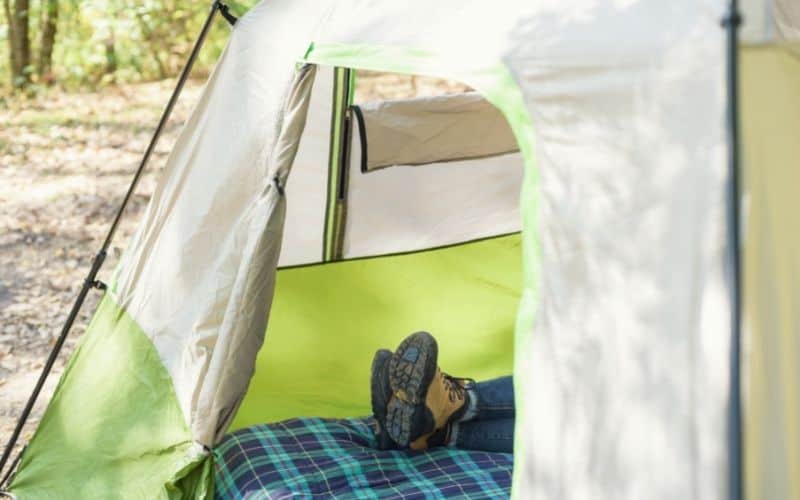
Comfort: Floor Space & Peak Height
The livable space of a tent is an important consideration and is influenced by the floor area, expected number of occupants, peak height, and shape of the pole structure. Backpacking tents tend to compromise on livability to minimize weight and packed size. Conversely, car camping tents offer more floor space, a taller peak height, and vertical walls.
While all tents give a capacity (i.e. the number of intended occupants), the marketing departments of these companies tend to be overly optimistic as to how many folks they can cram inside one of their products.
Instead of relying on this, take a look at the given floor space, and divide it by the number of occupants to work out how much sleeping space each camper would have.
At an absolute minimum, you’ll need around 13 square feet of floor space per sleeper. This assumes you’re happy being tightly packed in and there’ll be minimal gear with you inside. Car campers who plan to use air mattresses, cots or just want a more spacious, comfortable camping trip should look for something around 15-16 square feet (or higher) per person.
The REI Wonderland 4 and the NEMO Wagontop are the roomiest 4-person tents on our list. Both offer 69.4 sq. ft. of living space, which is big enough to fit in two double air mattresses with a few square feet left over.
The Thule Tepui Explorer Autana is the smallest at 48 square feet (12 sq. ft./person), although it does get some leeway – because it’s a rooftop model, you can store most of your gear in your SUV or truck.
For taller campers, peak height is one specification you’ll want to pay attention to. The peak height is the distance between the floor and the highest point of the tent. This will affect your ability to sit up straight in dome tents such as the Coleman Sundome (4’ 11”) and your ability to stand up inside in tunnel or cabin-style tents such as the Eureka Copper Canyon (7’).
Peak height doesn’t tell the full story though, as the overall shape will also affect the liveability. The structure of cabin tents is designed to create vertical or near-vertical walls which give more head and shoulder space. Dome style tents will arch towards the floor, meaning a rapid reduction in the height away from the apex.
The number of doors also impacts livability — if there is only a single door, then this could mean you need to clamber over your sleeping mates to exit for the bathroom. Multiple doors will allow you to get in and out of the shelter with greater ease.
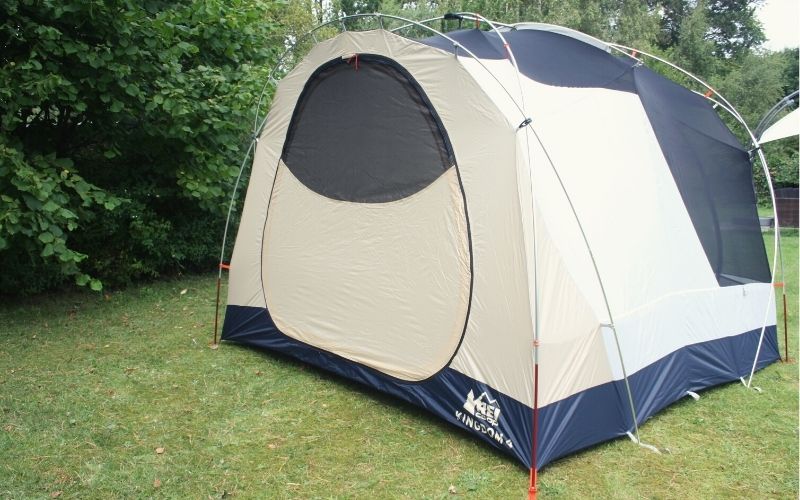
Weather Protection
How well a tent holds up in adverse weather is another important consideration. The required waterproofing level of your tent depends on the anticipated locations and seasons of your camping trips. Always ensure your safety by choosing a tent designed for the expected weather conditions; for instance, avoid using a two-season tent like the Coleman Sundome in cold weather.
Weather protection is determined by the tent’s shape, the strength of the poles, and its waterproofing. More expensive tents have better weather resistance because they are made of more advanced materials, have a full-coverage rainfly, and stronger poles. Be extremely wary of the weather protection offered by cheap tents unless you plan on fair-weather camping.
To determine how waterproof a tent is, take a look at the hydrostatic head (HH) of the rain fly and on the floor. Hydrostatic head is recorded in millimeters and is a measurement of the amount of water pressure a fabric can hold before it begins to seep through.
We’d recommend a rainfly with a HH value of 1000mm or above if you plan on camping in inclement weather during shoulder seasons, but many car-camping tents with a lower HH rating like the Coleman Sundome (600mm) or CORE Instant Dome (600mm) will be fine in short summer showers.
The shape of the shelter, the number of guy out points, and the strength of the poles will all determine how wind resistant it is. Cabin tents with straight vertical walls are the most vulnerable to the wind and their roofs can also gather water in heavy rain. The lower profile and rounded tent walls of dome tents make them more aerodynamic and better performers in high winds.
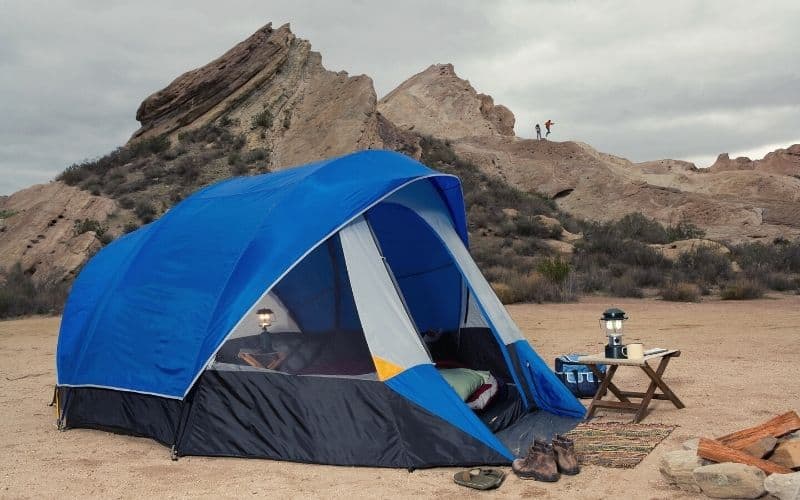
Ventilation
Ventilation is crucial for comfort during hot summer nights in your tent. A tent’s breathability is influenced by its design—single-wall or double-wall—, the materials used, and the quantity and location of vents in the rain fly. Be aware that waterproof coatings on a rainfly can substantially reduce fabric breathability, trapping warm and humid air inside.
Single-wall tents, such as the NEMO Wagontop, have a single layer of fabric that separates the interior from the outer environment. If there is a significant temperature difference between the two, and a lack of ventilation, a build-up of condensation can occur inside. The Wagontop gets around this by having large screened windows, although this reduces its weather resistance.
Many 4-person tents are built with a double-wall body consisting of the inner tent and the rain fly. This design helps to prevent a humid interior and condensation build-up by improving the airflow throughout.
The inner part is partially made of mesh, which allows humid air to escape and fresh air to enter. – the more mesh there is, the better the structure will breathe. In some models, added air vents in the rain fly allow warm and moist air to escape more quickly.
Some tents, like the REI Wonderland 4, have rainfly designs that can be easily rolled back in better weather conditions allowing for even better airflow.
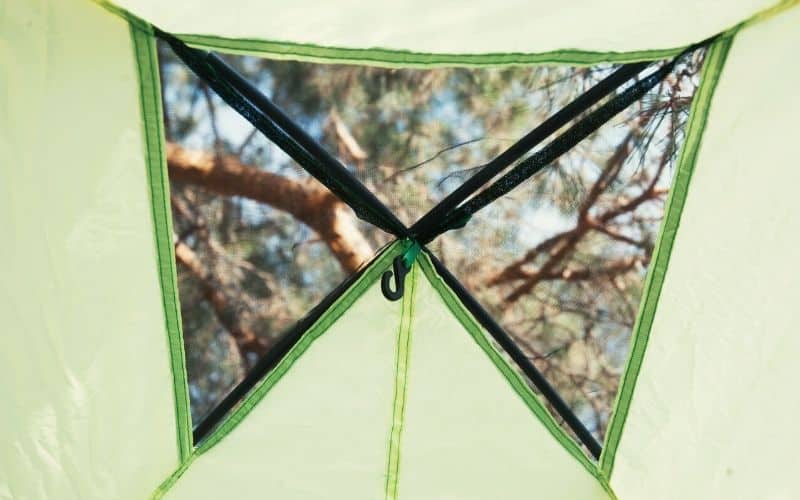
Quality and Durability
When searching for an excellent tent, assess its quality and durability, focusing on the resilience of the tent fabric and its poles.
The thickness of a tent’s fabric is measured in denier (D), which is proportional to durability. The denier rating of the fabric is a measurement of yarn weight and is often given by the manufacturer. The denier information of the tent floor, rainfly, and canopy is often listed as 10-300 denier (sometimes referred to as 10D-300D) and is typical for car camping tents.
Tent floors are most susceptible to punctures and tears, especially without a footprint, and are normally made with thicker materials than the rainfly.
In addition to the fabrics, take a look at the tent poles. A budget tent will use fiberglass poles, which are more prone to breaking than the lighter and more expensive aluminum poles used for manufacturing more premium tents.
The level of durability you require comes down to how often you’ll use it, and in what conditions. However, if you have kids, then your family tent will likely need a little extra toughness. For this, we recommend the NEMO Wagontop and the REI Wonderland, which are the most rip-resistant 4-person tents we tested.
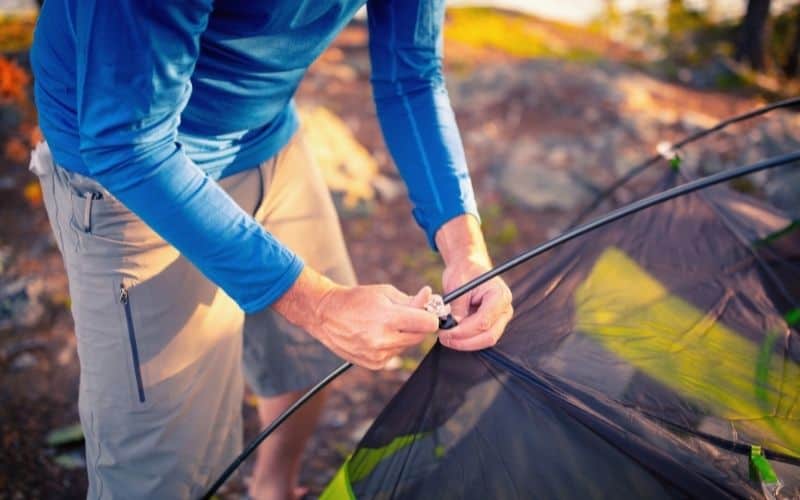
Setting Up & Taking Down
Consider the ease of setting up and dismantling your tent in your decision-making process. Although 4-person tents can be challenging to handle due to their size, many feature user-friendly design elements such as color-coded or pre-bent poles and clip-on mesh roofs, facilitating quick assembly.
Instant tents such as the Coleman Cabin Tent are designed so that they can be set up by one person with relative ease in just a minute or two. They’re the easiest to pitch because they have pre-attached poles connected directly to the fabric. These tents, however, can be heavier and are harder to repair should a component break.
We haven’t included any instant tents on our list, but the closest thing is the Eureka Copper Canyon, which goes from packed to pitched in 2/3 minutes thanks to color-coded poles and corner pole hubs.
At the other end of the spectrum, the NEMO Wagontop is the largest, and most difficult, to assemble in our test but, with a few practice attempts, it could be assembled by our reviewer on their own in around 8-10 minutes.
Weight and Packed Size
Whether you plan on backpacking or camping, how much a tent weighs will be of greater or lesser importance. Weight considerations are more important when hiking since backpackers have to carry the tent in their pack. Therefore the best tents for backpackers will be the ones with lower weight and packed size.
Weight can be affected by factors such as the size and capacity, materials used, and the type and shape of the shelter (freestanding vs non-freestanding, A-frame vs Dome).
If you’re planning on backpacking then a lightweight option such as the REI Trail Hut (8 lbs. 1.6 oz.) is a good option. If you can split the components amongst the occupants, then the Kelty Wireless (11 lbs. 14 oz.) is also a solid pick.
Car campers usually use larger, more durable, and therefore heavier 4-person tents. However, this extra weight is not much of an issue since you are unlikely to be carrying your gear far from your car to the pitch.
Most of the more comfortable tents such as the REI Wonderland 4 or the NEMO Wagontop are closer to 20 lbs. and have a packed size similar to a day hiking rucksack.

Storage Space: Pockets, Vestibules, And Gear Loft
An important consideration is how you intend to store gear when your camping. Many tents offer external storage in vestibules—extensions of the rainfly—for items like shoes, bags, and cooking equipment. Depending on their size, vestibules can also provide sheltered space for activities like sitting or cooking during rain.
If you need more space, then 4-person tents like the REI Wonderland have separate aftermarket add-on vestibules to extend the amount of storage and living space.
Interior storage options such as a gear loft and mesh pockets are useful for storing items such as headlamps, phones, maps, or spare clothing so they’re handy when we need them.
If you’re the type of camper who brings along a lot of gear then, the NEMO Wagontop is a great choice. This cabin tent has plenty of vestibule space and multiple interior pockets. At the other end of the scale is the Coleman Sundome, which only has a couple of pockets and no vestibules.
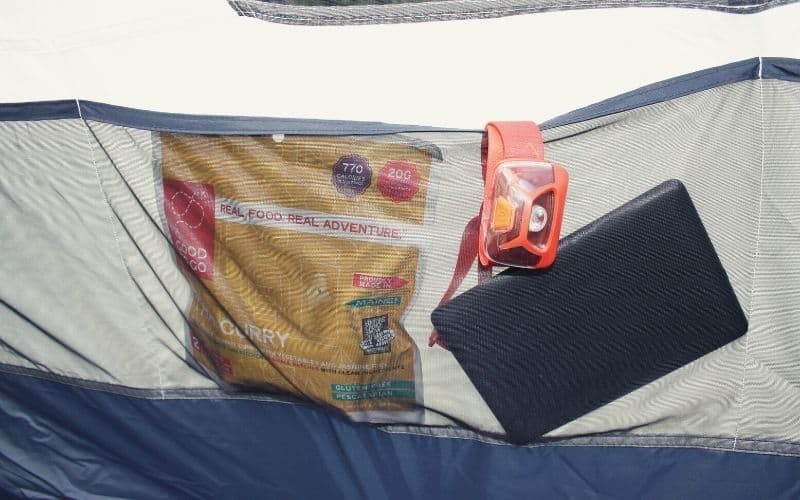
Best 4-Person Camping Tent: The Verdict
After much testing and deliberation, our standout favorite four-person camping tent is the wonderful REI Wonderland 4. The Wonderland is the new, updated, and improved version of the hugely popular REI Kingdom 4 and does everything its predecessor did – and a little bit more. It’s extra-roomy, waterproof, sturdy, easy to pitch, and as well-ventilated as tents come.
If the Wonderland’s a little too pricey for you, we recommend the Coleman Sundome or the Kelty Wireless 4. Both of these tents can’t match the overall quality of the Wonderland but have all the essentials at a lower price.
So, how did you like our article? If we missed anything or you have any questions, let us know! And if you’d like to share this post with your friends, please do!
